Uluwatu Temple, perched on a dramatic clifftop overlooking the Indian Ocean, is a sacred Balinese Hindu temple that captivates visitors with its stunning architecture, captivating Kecak dance performances, and breathtaking natural surroundings.
Constructed in the 11th century, Uluwatu Temple holds immense cultural and religious significance, serving as a site for traditional ceremonies and festivals that honor the Balinese deities.
Uluwatu Temple History
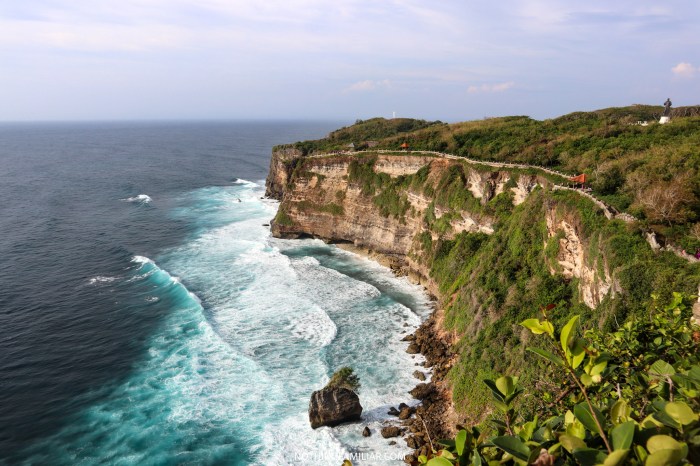
Uluwatu Temple, perched on the edge of a sheer cliff overlooking the Indian Ocean, holds a significant place in Balinese Hinduism. Its origins can be traced back to the 10th century, during the reign of King Marakata.
According to legend, the temple was built by a Javanese priest named Dang Hyang Nirartha. It is believed that he meditated on the cliff for several years before establishing the temple. Uluwatu Temple became a sacred site for Balinese Hindus, who believed it protected the island from evil spirits.
Cultural and Religious Importance
Uluwatu Temple is one of the six key temples in Bali, known as the Sad Kahyangan Jagat. It is dedicated to the god Rudra, a manifestation of Shiva, the destroyer and transformer. The temple is believed to guard the island’s southwestern region from negative forces.
Pilgrims from all over Bali visit Uluwatu Temple to pay homage and seek blessings. It is a popular destination for traditional ceremonies and festivals, such as the Piodalan Temple Anniversary and the Melasti Purification Ceremony.
Uluwatu Temple is a captivating coastal temple located in Bali, renowned for its stunning clifftop setting and sacred significance. After exploring this awe-inspiring site, consider venturing to Genting Highland , a vibrant hilltop resort in Malaysia, where you can indulge in thrilling attractions and breathtaking views.
Upon your return to Uluwatu Temple, immerse yourself once again in its serene atmosphere and witness the enchanting sunset views.
Role in Ceremonies and Festivals
Uluwatu Temple plays a central role in various Balinese ceremonies and festivals. During the Piodalan Temple Anniversary, the temple is decorated with colorful offerings and traditional dance performances are held.
The Melasti Purification Ceremony involves a procession of holy water from the temple to the beach, where it is used to purify the participants and the surrounding area. These ceremonies reinforce the temple’s spiritual significance and strengthen the bond between the community and the divine.
Uluwatu Temple Architecture
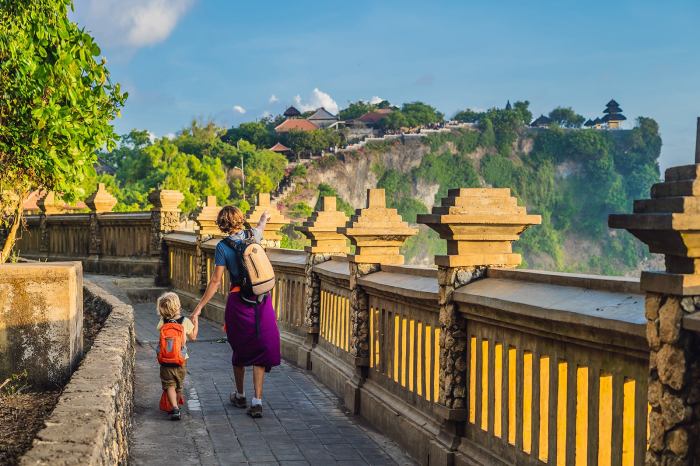
Uluwatu Temple is renowned for its exceptional architectural features, showcasing intricate carvings and tiered roofs that hold deep cultural and religious significance. Each element of the temple’s design carries symbolic meanings, reflecting the beliefs and traditions of Balinese Hinduism.
Tiered Roofs
The temple’s distinctive tiered roofs, known as “meru,” are a defining characteristic. These roofs symbolize Mount Meru, the sacred mountain in Hindu cosmology, which is believed to be the center of the universe. The number of tiers varies, with the most sacred shrines featuring eleven tiers, representing the eleven levels of spiritual attainment.
Intricate Carvings
Uluwatu Temple is adorned with exquisite carvings that depict scenes from Hindu mythology, such as the Ramayana and Mahabharata. These carvings serve as visual narratives, conveying religious stories and teachings. The intricate details and symbolism embedded within the carvings demonstrate the exceptional craftsmanship of Balinese artisans.
Construction Techniques and Materials
The temple was constructed using traditional Balinese building techniques and materials. The foundation and walls are made of coral, while the roofs are made of thatch. The use of these materials reflects the temple’s connection to the surrounding environment and the local building traditions of the Balinese people.
Uluwatu Temple Kecak Dance Performance
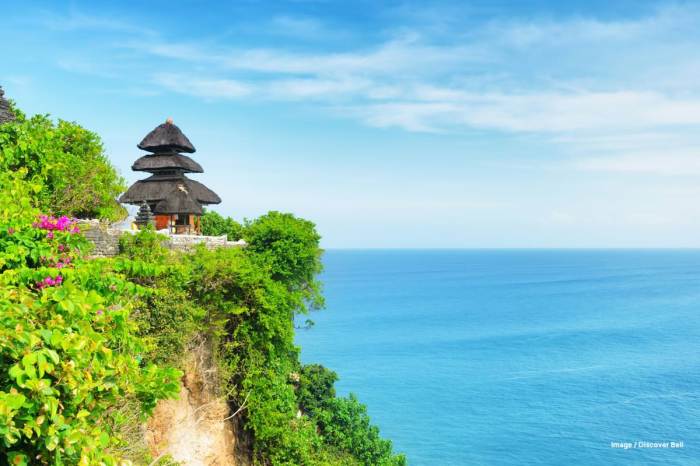
The Uluwatu Temple is not just a religious site but also a cultural hub, hosting the mesmerizing Kecak dance performance every evening. This traditional Balinese dance captivates audiences with its unique rhythm, chanting, and energetic movements.The Kecak dance, also known as the Ramayana Monkey Chant, has its roots in ancient rituals and storytelling traditions.
The Uluwatu Temple, perched on a dramatic cliff overlooking the Indian Ocean, is a must-visit destination in Bali. Its stunning architecture and sacred significance attract countless visitors each year. While in Bali, consider exploring central jakarta , a vibrant metropolis with a rich history and diverse culture.
Upon returning to Uluwatu Temple, be sure to witness the enchanting Kecak dance performance, an unforgettable cultural experience.
It originated in the 1930s when a German artist named Walter Spies witnessed a trance ritual in a village. Inspired by the rhythmic chanting and movements, he collaborated with local Balinese artists to develop the Kecak dance as a theatrical performance.
Costumes and Music
Performers wear traditional Balinese costumes, consisting of a black and white checkered sarong, a headdress made of coconut leaves, and a vest. The dance is accompanied by a chorus of male singers who create the percussive rhythm by chanting “cak, cak, cak” in unison.
Performance, Uluwatu temple
The Kecak dance depicts scenes from the Hindu epic Ramayana, particularly the battle between Rama and Ravana. The dancers form a circle around a central fire, symbolizing the forest where the story unfolds. The movements are dynamic and expressive, with dancers using their bodies to represent characters, animals, and the elements of nature.The performance is highly energetic and engaging, with the audience often drawn into the rhythm and energy of the dance.
The sacred Uluwatu Temple, perched on the rugged coastline of Bali, offers breathtaking views of the Indian Ocean. If you’re looking for a vibrant city experience, consider visiting Seattle. Despite the distance, the spirit of adventure that permeates both Uluwatu Temple and the bustling streets of Seattle will surely captivate you.
As you explore Uluwatu’s ancient ruins and witness traditional ceremonies, let the allure of Seattle inspire you to plan your next urban escape.
The Kecak dance at Uluwatu Temple is a unique and unforgettable experience that showcases the rich cultural heritage of Bali.
Uluwatu Temple Surroundings

Uluwatu Temple is renowned not only for its spiritual significance but also for its breathtaking natural surroundings. The temple is perched on a sheer limestone cliff, offering panoramic views of the Indian Ocean. The coastal scenery is simply stunning, with waves crashing against the cliffs below and lush vegetation carpeting the surrounding hills.
Flora and Fauna
The area around Uluwatu Temple is home to a diverse array of plant and animal life. The lush vegetation includes various tropical trees, shrubs, and flowers, creating a vibrant and colorful landscape. The temple grounds are also home to a number of wildlife species, including monkeys, bats, and birds.
Visitors may even be lucky enough to spot sea turtles nesting on the nearby beaches.
Uluwatu Temple Tourism
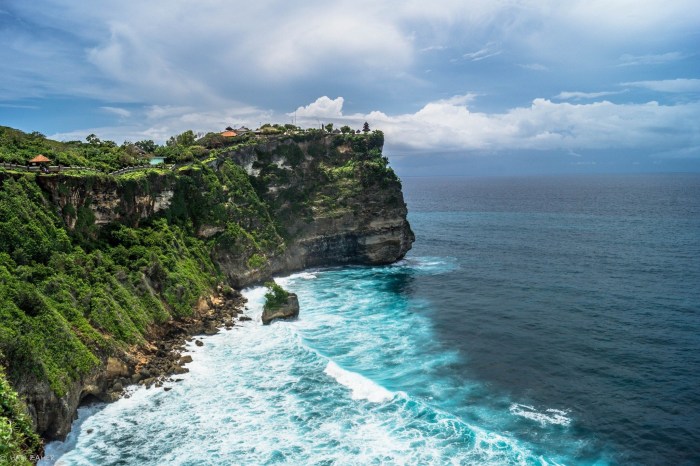
Uluwatu Temple is a popular tourist destination in Bali, attracting both domestic and international visitors. Its stunning coastal location, unique architecture, and captivating Kecak dance performances make it a must-visit for anyone exploring the island.
The temple offers a range of amenities and facilities to enhance the visitor experience. These include well-maintained pathways, ample parking, and several restaurants and cafes serving local and international cuisine. Visitors can also purchase souvenirs and handicrafts from the many stalls located within the temple grounds.
Planning a Visit
To make the most of your visit to Uluwatu Temple, consider the following tips:
- Best Time to Visit:The best time to visit Uluwatu Temple is during the late afternoon, around sunset. This allows you to witness the breathtaking sunset views and enjoy the Kecak dance performance.
- What to Expect:Be prepared for crowds, especially during peak tourist season. Wear comfortable shoes as you will be doing some walking. Respect the sacred nature of the temple and dress modestly.
- Entrance Fee:There is an entrance fee to enter the temple, which includes access to the Kecak dance performance. Check the official website for the latest fee information.
- Photography:Photography is permitted within the temple grounds, but be respectful of the religious significance of the site.
Closing Summary
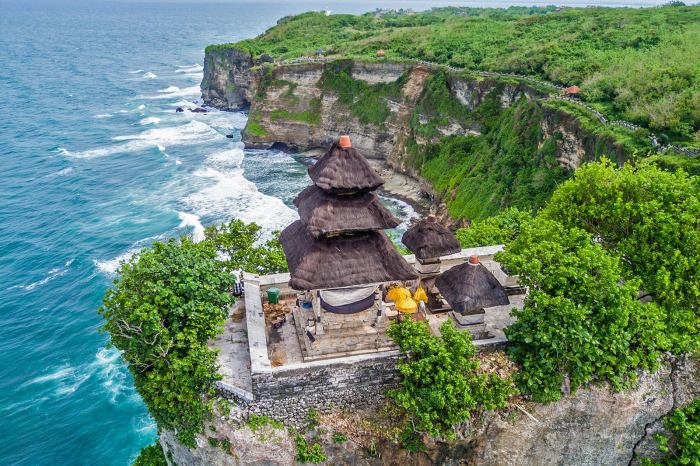
Uluwatu Temple is a true gem of Bali, offering a harmonious blend of spirituality, culture, and natural beauty. Whether you’re seeking a profound spiritual experience, an appreciation for traditional arts, or simply breathtaking coastal views, Uluwatu Temple promises an unforgettable encounter.
Frequently Asked Questions
Is Uluwatu Temple open to tourists?
Yes, Uluwatu Temple is open to tourists and welcomes visitors from all backgrounds.
What is the best time to visit Uluwatu Temple?
The best time to visit Uluwatu Temple is during the late afternoon, as you can witness the enchanting sunset over the Indian Ocean.
Is it possible to swim near Uluwatu Temple?
Swimming is not permitted in the immediate vicinity of Uluwatu Temple due to strong currents and rocky shores.